|
Scarecrows

The scarecrow
has an established place in English folklore and fiction because it was once a familiar sight in the countryside, a crude figure made of sticks and straw, old ragged clothes and often a large turnip or a mangelwurzel for a head, assembled to look like a human being and set up in a field to frighten the birds away from growing crops. The term dates back to 1592 and other ideas associated with it, such as someone whose dress and appearance is gaunt, ridiculous or unkempt, also stem from the late 16th century.
They are a rare sight today having been displaced by other apparatus for scaring off birds such as gas guns which go off automatically at intervals, by high flying kites and similar wind-powered contrivances, but they can occasionally be seen in the fields, standing like silent sentinels guarding rows of green shoots just breaking the surface in the hope of deterring marauders from flying in to feed off them.
It is therefore a delight to spot one as you drive through the countryside as we did in February 2000. In fact there were several of them in a green field of forage rape alongside the B1176 a few miles south of Little Bytham, near Bourne, all hastily put together from lengths of wood, old overalls and white plastic chemical containers for their heads with coloured streamers attached to their arms, fluttering wildly in the breeze to give added movement in an attempt to keep the birds at bay.

Those birds which belong to the
corvidae or crow family were their original target in years past and these include the raven, the rook and the jackdaw, the jay and the magpie, because these birds are omnivorous and will eat animal, fish and vegetable food indifferently, showing themselves very adaptable to circumstances and will devour almost anything edible. The crow is regarded by many naturalists as the highest family of birds and their intelligence is great in the extreme and innumerable stories are told of their craft and cunning to ensure that they get a good meal and they are particularly partial to new green shoots. In past times, especially during the 19th century, children played truant from school to earn a few pennies from local farmers by scaring the crows away from their crops in the sensitive seasons of the year and the only weapons they had were their loud voices, sometimes wooden rattles, but mostly the stones they picked up in the fields to throw at them, hence the saying that is still with us today: stone the crows.
Although crows were once the main pests, wood pigeons are now regarded as the archenemies of the farmer and with some justification. The pigeon will eat practically anything he cares to grow at any time of the year and consequently the bird is a recognised pest and the latest count suggests that the population in this country is in excess of 18 million and so farmers mount Pigeon Days every year when they turn out with their shotguns to shoot as many as they can and so reduce the damage to their crops, although in recent years they have also been killing magpies and jays, much to the dismay of bird lovers and animal welfare organisations such as the Royal Society for the Protection of Birds.
Myth and legend have grown up around these rustic, makeshift dummies, often because of the discarded clothes used to dress them up because many people, especially in country areas, had a half-forgotten fear of witchcraft and one of its beliefs was that old clothes could be used to influence the original owner, for good or more usually evil, if they had been given away or used for another purpose, even from a distance and when the physical contact had been completely broken. Superstition was such that old clothes, a dress, a coat or even an old glove, might be used for malicious spells, and so owners were reluctant to have them used for scarecrows.
Nevertheless, they have remained a popular method of scaring the birds through the centuries and although now fast disappearing from our fields, the scarecrow still has a place in our affection. An annual scarecrow festival is held every August in the village of Kettlewell in the heart of the Yorkshire Dales where over 100 life-size models go on display to celebrate this traditional country skill. Similar festivals are held in America but usually coincide with Halloween while in Kansas, the Topeka Scarecrows are one of the top ice hockey teams in the American Central Hockey League.
The scarecrow has also had an attraction for writers and film makers for many years, among the earliest being The Scarecrow, a play written by the American Percy MacKaye in 1908 about a scarecrow being brought to life which was made into a silent film Puritan Passions and was successfully revived on Broadway in 1953. Who cannot forget the scene in the 1933 Hollywood version of The Invisible Man, the film that made Claude Rains a star, in which the unseen fugitive is pursued across the moors by the police in cold weather and eventually seeks warmth from the clothes he steals from the scarecrow he finds in a field, one of the great moments in screen history? There have been many film references to scarecrows since, including Dr Syn Alias the Scarecrow, the 1962 version of Russell Thorndike's novel about the smuggling Vicar of Dymchurch who disguises himself as a scarecrow to protect his identity, while the latest is the 1998 slice of horror hokum called Scarecrows directed by William Wesley in which robbers holding a farmer and his teenage daughter hostage in a remote farmhouse are killed off one by one by a group of living scarecrows.
|
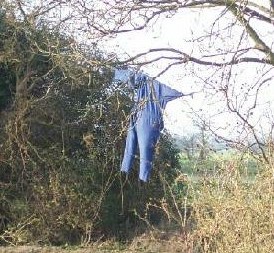 |
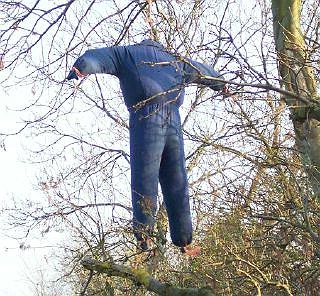 |
|
Aerial scarecrows
made from old sets of blue overalls, pictured on
farmland
near Dyke village and (below) old boiler suits provide the basis for two
scarecrows in a field of peas off Mill Drove. |
|
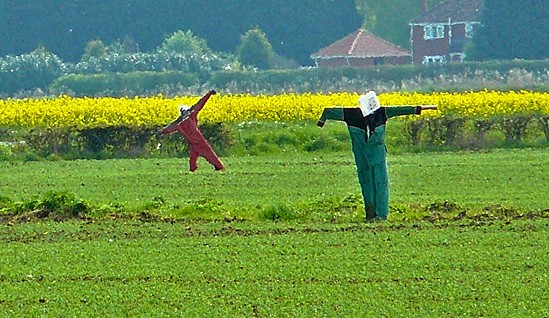 |
|
 |
They also have a great appeal to children and one of the most memorable appearances came in the well-loved 1939 film The Wizard of Oz when Ray Bolger as the Scarecrow joins Judy Garland and her assorted friends in their journey down the yellow brick road. The use of the mangelwurzel for the head of a scarecrow was also the inspiration for one of the most famous scarecrows in fiction, Worzel Gummidge, created by the American writer Barbara Euphan Todd (1890-1976) and immortalised by the actor, the late Jon Pertwee, and which delighted television audiences in England from 1979-1982 and later in Australia.
Scarecrows, it would seem, are now far more in evidence on the screen and in the realms of the imagination than in the fields they have occupied since they first appeared in the rural landscape of 400 years ago. Modern devices may have taken their place but for someone who remembers the customary scarecrows from England's past, the sight of one standing incongruously in the middle of a field today is sufficient to make me stop and stay awhile, to think of man's ingenuity and to remember the way our countryside once was.
Old methods of scaring crows, however, persist in the countryside and this
photograph was taken in April 2003 on farmland in South Lincolnshire, showing evidence of a barbaric practice, one that was popular
in years past but should have disappeared long ago as we became more aware of our environment.
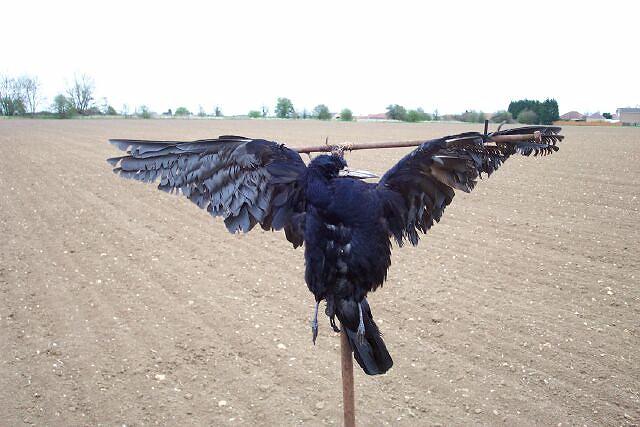
There was once a custom among gamekeepers of selecting a fence or erecting a post and using it as a gibbet upon which they hung the many and varied carcasses
which fell to their guns as trophies of their skill and watchfulness. The bodies were also intended as a warning to others that they too might suffer the same fate.
On these gibbets you were likely to find the corpses of foxes, stoat, weasel, mink, and occasionally owls, all in various stages of decay, and even in this enlightened age, some gamekeepers still shoot them. Ranged alongside them you would most certainly find every member of the crow family, a species that is more conspicuous
in springtime as they seek out food wherever they can find it, particularly on farmland among sprouting crops of wheat and sugar beet.
On the day I took this photograph, several posts had been erected at various points around a field that had been newly sown with spring wheat between the northern edge of Bourne and Dyke village and each one carried the carcass of a crow, all recently shot.
I found three dead birds, each strung out as though crucified, and a fourth pinioned to the ground nearby. They were obviously meant as warnings to others to keep away because of the bad reputation that birds of the
corvidae or crow family have among farmers. The display was particularly offensive because it was close to a public footpath and, more importantly, in full view of a row of houses bordering the field and therefore witnessed by the families who live there, most of them with young children who are taught at school and by our many conservation organisations that we should treat our wildlife with care and respect.
This practice seemed to be both primitive and cruel and so I asked the Royal Society for the Protection of Birds for their opinion and Wildlife Adviser, Michael Pinhorn, told me:
Under the provisions of the Wildlife and Countryside Act, it is legal to control certain species of birds, which includes most of the crow family, woodpigeons and doves, herring gulls, starlings and sparrows. However, the criteria for killing the birds or destroying their nests are they must be (1) a serious threat to agriculture or (2) to preserve public health or air safety and to conserve wild birds. Therefore, the farmer is quite within his rights to shoot these birds all through the week but he must be able to show he is working within the framework of the law. The staking out of dead birds to deter others of the same species is an ancient practice, leftover from bygone days and as far as I can tell, totally ineffective. Cases have been reported to the RSPCA and the police, but they seem powerless to prevent this disgusting practice.
This reply from the RSPB appears to sum up the current situation for although this method of controlling pests may have been prevalent in times past, I fear that it owes more to superstition than practicality because the crows were back in large numbers before nightfall and they have been flocking there ever since.
|
ALLOTMENT SCARECROWS |
|
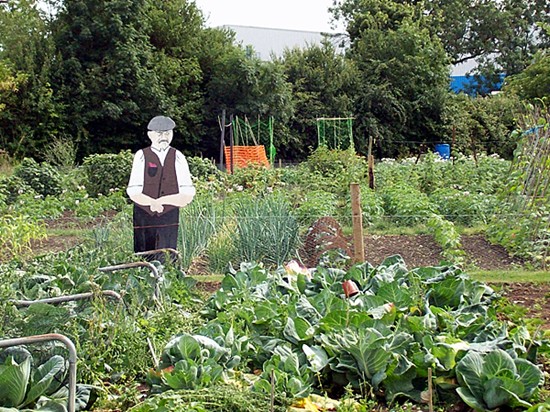 |
|
It is not just farmers who find scarecrows
useful but also gardeners and the allotment holders with plots off
the Spalding Road owned by Bourne United Charities are to be
commended for their ingenuity, especially with the painted model
(above) which indicates that the owner not only has green fingers
but is also a dab hand with the paint brush. |
|
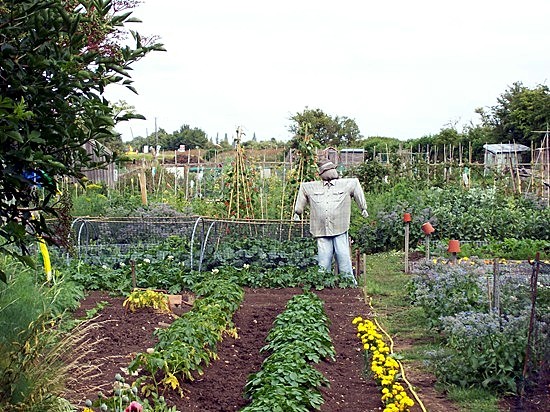 |
REVISED SEPTEMBER 2014
See also
Dyke Scarecrow
Festival

Go to:
Main Index Villages
Index
|








